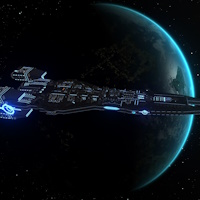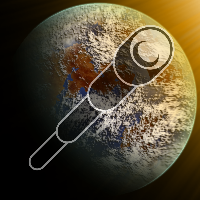Geography
Location
Tellus orbits within the Toliman Belt in the α Cen B subsystem, nestled comfortably in the inner habitable zone between
Vulcan and
Minerva. Presumably to maintain its orbital stability, it was placed in a 3:2 mean-motion orbital resonance with Minerva, though why this orbit was chosen instead of a simple trojan co-orbit in the Minerva L4 or L5 regions is unknown. The ring rotates about once every half hour and is tilted about 22.5° on its axis of rotation to create a light/dark cycle on the interior surface. The size of the object combined with its rate of rotation produces a net centrifugal force equivalent to the surface gravity of
Hemera —a comfortable 9.1 m/s
2.
Structure
The Tellus Ring is one of the largest single artificial structures in known space: 2124 kilometers in diameter and nearly 6700 kilometers in circumference. The width across the band from airwall to airwall is exactly one twelfth of the structure's radius (88.5 km), a hallmark of the skgri civilization's base-12 mathematic system. The total habitable area on the inner surface of the ring is nearly six hundred thousand square kilometers, multiplied by a dozen lower levels between the inner and outer surfaces.
Inner Surface
The interior surface is lined with natural substrate, anywhere between twenty and two hundred meters thick and sculpted into landmasses and seas. This artificial landscape sprawls under a halo-shaped, nitrogen-oxygen sky kept in place by centrifugal force and nine-kilometer-high walls on either rim. Below this (and protruding above the surface in some places) is a complex maze of chambers and passages that make up the bulk of the ring's foundational structure. Less than half of this labyrinth has been fully explored to date. All across the inner surface of Tellus, vast cities lie dormant. They are thousands of years more advanced than that of modern interstellar civilization, yet they have been left to ruin and claimed by the nature that
their builders had imported.
Outer Surface
The outside of the ring is almost entirely paved with solar panels, providing electrical power for the stationkeeping system, automated defenses, and certain elements of land-side infrastructure. A portion of this energy is also used to generate an artificial magnetosphere through a network of super-conducting coils and wires, preventing atmospheric erosion from the solar wind. However, the main source of energy for the facilities on the ring is suspected to have been a system-wide laser-beamed energy network that no longer exists. The air-walls of the ring are lined with radiators that both maintain the temperature of the habitat and exude excess heat into space. The ring also has scoop docks along the bottom, some with apertures more than a kilometer across.
Ecosystem
Life thrives on the inner surface of the ring. Extensive research indicates that the organisms present are recent descendants of a selection of lifeforms from Hemera. Much like
humans have done with
Mars, the skgri populated Tellus (and their other constructs) with organisms without regard for their biogeography on the homeworld, instead opting to create new hybrid biotopes unique to the ring. The initial stock of Tellus were chosen deliberately -and in some cases, genetically modified- to create an array of self-sustaining ecosystems for the various biomes present on the structure. While it has not been long enough for significant natural evolutionary radiation to occur on Tellus, the disappearance of the skgri'i and ensuing lack of artificial ecosystem regulation drove some species to extinction and others into new niches.
Natural Resources
Tellus is not a natural object and is also not especially large in terms of planetary scale. It has very little mass to spare, and in fact the current human inhabitants of the ring need to
import a fair amount of resources to keep their settlements operational. However, the thing that Tellus is richest in is information. Generations of archaeologists, biologists, technologists, linguists, and other assorted academics have spent lifetimes studying the incredible trove of knowledge that Tellus represents. Though information recovered directly from databanks on Tellus is rather rare, the construct and everything it contains comprise an invaluable window into the skgri civilization as it was more than ten millennia ago.
Inhabitants
The original inhabitants of the Tellus Ring were its builders: the
skgri'i. Extrapolation based on the mapped regions of the ring put the total occupancy somewhere around 240 million, with ample room for wilderness, recreation, agriculture, and infrastructure. Wreckage documented in the Toliman Belt indicates at least eleven more rings identical to Tellus once orbited in an evenly-spaced configuration, meaning that just over ten thousand years ago the Toliman Belt alone held some three billion skgri lives in its span. The ultimate fate of the ring's first populace, like the fate of the entire
skgri civilization, is unknown.
In the modern age the ring bears a tiny fraction of its capacity. Just over three hundred thousand people, the vast majority of them
human, have taken up residence in one of the abandoned cities and its associated sublevel structures. The city of Atlantis serves as the hub of all activities on the ring, overseen by the
Centauri Republic through the Tellus Ring Survey Administration. Over the last few centuries it has grown in size and providence as more and more explorers, academics, and support crew have immigrated from across the system (and occasionally from other systems) in pursuit of the ancient secrets the ring holds.
History
When
humankind sent some of their first interstellar probes, the
Sojourner twins, to the neighboring Alpha Centauri system, they had no idea what they would find. The
Sojourners’ predecessor, the
Darwin probe, had already discovered complex life on
a frigid moon in the
Proxima Centauri system, showing humanity they still had much to learn about the cosmos. With the
Sojourners, all bets were off. The one thing they never expected to find, of course, was an abandoned alien megastructure -which was exactly what
Sojourner 2 discovered orbiting Alpha Centauri B. Dubbed the Tellus Ring, after an ancient Roman goddess of the Earth, its discovery changed humanity’s understanding of the universe forever. But questions about its origins would only be answered with centuries of research and further interstellar exploration.
It was recognized, relatively soon after human explorers arrived in the Alpha Centauri system, that Tellus was the sole surviving construct in its debris belt: the debris was, largely, parts of destroyed ringworlds and other megastructures. Similar destruction has been found in every other system once inhabited by the ancients, leading xenoarchaeologists to suspect
a vast and cataclysmic war as the cause of their extinction. Yet, by some grace of powers unknown, some products of their great hubris still survive, overgrown and feral with the loss of their mysterious ancient wardens. While many other examples of ancient constructs have since been adopted and restored by humanity in their attempt to decipher the lost history of this ancient civilization, Tellus remains a lone monument to the tenacity of life -even when taken from its home and subjected to existential threat, it will endure and, in time, thrive.











Man your sidebar information is absolutely on point, feels as fleshed out as a real place! Well done!
Thanks so much, Barron!! I do love cramming information into the sidebar, hehe. Realism is the goal here and I'm very pleased to hear I hit the mark!